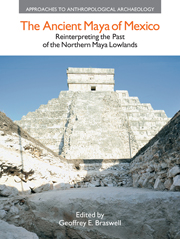Book contents
- Frontmatter
- Dedication
- Contents
- Contributors
- List of Figures
- List of Tables
- 1 The Ancient Maya of Mexico: Reinterpreting the Past of the Northern Maya Lowlands
- Part I THE PRECLASSIC PERIOD
- Part II THE EARLY AND LATE CLASSIC PERIODS
- 5 Urbanism, Architecture, and Internationalism in the Northern Lowlands during the Early Classic
- 6 The Political and Economic Organization of Late Classic States in the Peninsular Gulf Coast: The View from Champoton, Campeche
- 7 5,000 Sites and Counting: The Inspiration of Maya Settlement Studies
- Part III THE TERMINAL CLASSIC AND EARLY POSTCLASSIC PERIODS
- Part IV THE LATE POSTCLASSIC TO HISTORICAL PERIODS
- Part V CONCLUSIONS
- Index
7 - 5,000 Sites and Counting: The Inspiration of Maya Settlement Studies
from Part II - THE EARLY AND LATE CLASSIC PERIODS
- Frontmatter
- Dedication
- Contents
- Contributors
- List of Figures
- List of Tables
- 1 The Ancient Maya of Mexico: Reinterpreting the Past of the Northern Maya Lowlands
- Part I THE PRECLASSIC PERIOD
- Part II THE EARLY AND LATE CLASSIC PERIODS
- 5 Urbanism, Architecture, and Internationalism in the Northern Lowlands during the Early Classic
- 6 The Political and Economic Organization of Late Classic States in the Peninsular Gulf Coast: The View from Champoton, Campeche
- 7 5,000 Sites and Counting: The Inspiration of Maya Settlement Studies
- Part III THE TERMINAL CLASSIC AND EARLY POSTCLASSIC PERIODS
- Part IV THE LATE POSTCLASSIC TO HISTORICAL PERIODS
- Part V CONCLUSIONS
- Index
Summary
Abstract
This chapter describes a long-term mapping project designed to create a database of all known Maya sites, inspired originally by E. Wyllys Andrews V. To date, more than 5,000 Maya archaeological sites have been located and positioned on a master map, and data suitable for GIS analysis have been recorded in a public-access website. Data have been used by a wide range of scholars, by graduate and undergraduate students, and by primary and secondary school students and their teachers.
One of our early Will Andrews-inspired projects was computer-based—bringing LANDSAT data, first available in 1978, to the PC level for further analysis. We were interested then in a project that fascinated many others, including Tom Sever and Charles Duller: recognition of Maya sites from remote sense data. Over the last 18 years, that interest has evolved into a longlasting project. The project is the Electronic Atlas of Ancient Maya Sites (EAAMS; Brown and Witschey 2000, 2001, 2002, 2010; Witschey and Brown 2001, 2002). It is a compendium of site-location data and other information about published Maya sites. Details of the organization of the site data, our earlier research, and data in a form for use with Google Earth may all be found on our project website (http://MayaGIS.smv.org).
Archaeological research on the ancient Maya has traditionally focused on the site as the unit of study and analysis. Most projects focus on mapping and excavating a single site and, furthermore, they often devote most of their efforts to studying monumental ceremonial and public buildings. The late 1950s and early 1960s witnessed archaeological projects that began to correct the disproportionate attention given to the temples, tombs, and palaces.
- Type
- Chapter
- Information
- The Ancient Maya of MexicoReinterpreting the Past of the Northern Maya Lowlands, pp. 170 - 188Publisher: Acumen PublishingPrint publication year: 2012



